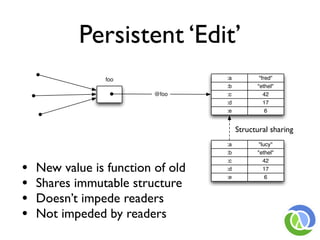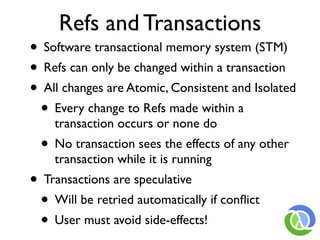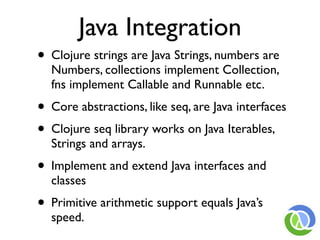Clojure A Dynamic Programming Language for the JVM
- 1. Clojure A Dynamic Programming Language for the JVM Rich Hickey
- 2. Clojure Fundamentals • 3 years in development, released 10/2007 • A new Lisp, not Common Lisp or Scheme • Functional • emphasis on immutability • Supporting Concurrency • language-level coordination of state • Designed for the JVM • exposes and embraces platform
- 3. Clojure is a Lisp • Dynamically typed, dynamically compiled • Interactive - REPL • Load/change code in running program • Code as data - Reader • Small core • Sequences • Syntactic abstraction - macros • Not Object-oriented
- 4. Atomic Data Types • Arbitrary precision integers -12345678987654 • Doubles , BigDecimals 1.234 1.234M • Ratios -22/7 • Strings -“fred”, Characters -a b c • Symbols - fred ethel , Keywords - :fred :ethel • Booleans - true false , Null - nil • Regex patterns #“a*b”
- 5. Data Structures • Lists - singly linked, grow at front • (1 2 3 4 5), (fred ethel lucy), (list 1 2 3) • Vectors - indexed access, grow at end • [1 2 3 4 5], [fred ethel lucy] • Maps - key/value associations • {:a 1, :b 2, :c 3}, {1 “ethel” 2 “fred”} • Sets #{fred ethel lucy} • Everything Nests
- 6. Syntax • You’ve just seen it • Data structures are the code • Not text-based syntax • Syntax is in the interpretation of data structures • Things that would be declarations, control structures, function calls, operators, are all just lists with op at front • Everything is an expression
- 7. # Norvig’s Spelling Corrector in Python # http://norvig.com/spell-correct.html def words(text): return re.findall('[a-z]+', text.lower()) def train(features): model = collections.defaultdict(lambda: 1) for f in features: model[f] += 1 return model NWORDS = train(words(file('big.txt').read())) alphabet = 'abcdefghijklmnopqrstuvwxyz' def edits1(word): n = len(word) return set([word[0:i]+word[i+1:] for i in range(n)] + [word[0:i]+word[i+1]+word[i]+word[i+2:] for i in range(n-1)] + [word[0:i]+c+word[i+1:] for i in range(n) for c in alphabet] + [word[0:i]+c+word[i:] for i in range(n+1) for c in alphabet]) def known_edits2(word): return set(e2 for e1 in edits1(word) for e2 in edits1(e1) if e2 in NWORDS) def known(words): return set(w for w in words if w in NWORDS) def correct(word): candidates = known([word]) or known(edits1(word)) or known_edits2(word) or [word] return max(candidates, key=lambda w: NWORDS[w])
- 8. ; Norvig’s Spelling Corrector in Clojure ; http://en.wikibooks.org/wiki/Clojure_Programming#Examples (defn words [text] (re-seq #"[a-z]+" (.toLowerCase text))) (defn train [features] (reduce (fn [model f] (assoc model f (inc (get model f 1)))) {} features)) (def *nwords* (train (words (slurp "big.txt")))) (defn edits1 [word] (let [alphabet "abcdefghijklmnopqrstuvwxyz", n (count word)] (distinct (concat (for [i (range n)] (str (subs word 0 i) (subs word (inc i)))) (for [i (range (dec n))] (str (subs word 0 i) (nth word (inc i)) (nth word i) (subs word (+ 2 i)))) (for [i (range n) c alphabet] (str (subs word 0 i) c (subs word (inc i)))) (for [i (range (inc n)) c alphabet] (str (subs word 0 i) c (subs word i))))))) (defn known [words nwords] (for [w words :when (nwords w)] w)) (defn known-edits2 [word nwords] (for [e1 (edits1 word) e2 (edits1 e1) :when (nwords e2)] e2)) (defn correct [word nwords] (let [candidates (or (known [word] nwords) (known (edits1 word) nwords) (known-edits2 word nwords) [word])] (apply max-key #(get nwords % 1) candidates)))
- 9. Java Interop Math/PI 3.141592653589793 (.. System getProperties (get "java.version")) "1.5.0_13" (new java.util.Date) Thu Jun 05 12:37:32 EDT 2008 (doto (JFrame.) (add (JLabel. "Hello World")) pack show) ;expands into: (let [x (JFrame.)] (do (. x (add (JLabel. "Hello World"))) (. x pack) (. x show)) x)
- 10. Clojure is Functional • All data structures immutable • Core library functions have no side effects • Easier to reason about, test • Essential for concurrency • Functional by convention insufficient • let-bound locals are immutable • loop/recur functional looping construct • Higher-order functions
- 11. Sequences (drop 2 [1 2 3 4 5]) -> (3 4 5) (take 9 (cycle [1 2 3 4])) -> (1 2 3 4 1 2 3 4 1) (interleave [:a :b :c :d :e] [1 2 3 4 5]) -> (:a 1 :b 2 :c 3 :d 4 :e 5) (partition 3 [1 2 3 4 5 6 7 8 9]) -> ((1 2 3) (4 5 6) (7 8 9)) (map vector [:a :b :c :d :e] [1 2 3 4 5]) -> ([:a 1] [:b 2] [:c 3] [:d 4] [:e 5]) (apply str (interpose , "asdf")) -> "a,s,d,f" (reduce + (range 100)) -> 4950
- 12. Maps and Sets (def m {:a 1 :b 2 :c 3}) (m :b) -> 2 ;also (:b m) (keys m) -> (:a :b :c) (assoc m :d 4 :c 42) -> {:d 4, :a 1, :b 2, :c 42} (merge-with + m {:a 2 :b 3}) -> {:a 3, :b 5, :c 3} (union #{:a :b :c} #{:c :d :e}) -> #{:d :a :b :c :e} (join #{{:a 1 :b 2 :c 3} {:a 1 :b 21 :c 42}} #{{:a 1 :b 2 :e 5} {:a 1 :b 21 :d 4}}) -> #{{:d 4, :a 1, :b 21, :c 42} {:a 1, :b 2, :c 3, :e 5}}
- 13. Persistent Data Structures • Immutable, + old version of the collection is still available after 'changes' • Collection maintains its performance guarantees • Therefore new versions are not full copies • Structural sharing - thread safe, iteration safe • All Clojure data structures are persistent • Hash map/set and vector based upon array mapped hash tries (Bagwell) • Practical - much faster than O(logN)
- 15. Concurrency • Conventional way: • Direct references to mutable objects • Lock and worry (manual/convention) • Clojure way: • Indirect references to immutable persistent data structures (inspired by SML’s ref) • Concurrency semantics for references • Automatic/enforced • No locks in user code!
- 16. Typical OO - Direct references to Mutable Objects foo :a ? :b ? :c 42 :d ? :e 6 • Unifies identity and value • Anything can change at any time • Consistency is a user problem
- 17. Clojure - Indirect references to Immutable Objects foo :a "fred" :b "ethel" @foo :c 42 :d 17 :e 6 • Separates identity and value • Obtaining value requires explicit dereference • Values can never change • Never an inconsistent value
- 18. Persistent ‘Edit’ foo :a "fred" :b "ethel" @foo :c 42 :d 17 :e 6 Structural sharing :a "lucy" :b "ethel" • :c 42 New value is function of old :d 17 • :e 6 Shares immutable structure • Doesn’t impede readers • Not impeded by readers
- 19. Atomic Update foo :a "fred" :b "ethel" :c 42 :d 17 :e 6 @foo Structural sharing :a "lucy" :b "ethel" • Always coordinated :c 42 :d 17 • Multiple semantics :e 6 • Next dereference sees new value • Consumers of values unaffected
- 20. Clojure References • The only things that mutate are references themselves, in a controlled way • 3 types of mutable references, with different semantics: • Refs - Share synchronous coordinated changes between threads • Agents - Share asynchronous autonomous changes between threads • Vars - Isolate changes within threads
- 21. Refs and Transactions • Software transactional memory system (STM) • Refs can only be changed within a transaction • All changes are Atomic, Consistent and Isolated • Every change to Refs made within a transaction occurs or none do • No transaction sees the effects of any other transaction while it is running • Transactions are speculative • Will be retried automatically if conflict • User must avoid side-effects!
- 22. The Clojure STM • Surround code with (dosync ...) • Uses Multiversion Concurrency Control (MVCC) • All reads of Refs will see a consistent snapshot of the 'Ref world' as of the starting point of the transaction, + any changes it has made. • All changes made to Refs during a transaction will appear to occur at a single point in the timeline. • Readers never impede writers/readers, writers never impede readers, supports commute
- 23. Refs in action (def foo (ref {:a "fred" :b "ethel" :c 42 :d 17 :e 6})) @foo -> {:d 17, :a "fred", :b "ethel", :c 42, :e 6} (assoc @foo :a "lucy") -> {:d 17, :a "lucy", :b "ethel", :c 42, :e 6} @foo -> {:d 17, :a "fred", :b "ethel", :c 42, :e 6} (commute foo assoc :a "lucy") -> IllegalStateException: No transaction running (dosync (commute foo assoc :a "lucy")) @foo -> {:d 17, :a "lucy", :b "ethel", :c 42, :e 6}
- 24. Agents • Manage independent state • State changes through actions, which are ordinary functions (state=>new-state) • Actions are dispatched using send or send-off, which return immediately • Actions occur asynchronously on thread-pool threads • Only one action per agent happens at a time
- 25. Agents • Agent state always accessible, via deref/@, but may not reflect all actions • Can coordinate with actions using await • Any dispatches made during an action are held until after the state of the agent has changed • Agents coordinate with transactions - any dispatches made during a transaction are held until it commits • Agents are not Actors (Erlang/Scala)
- 26. Agents in Action (def foo (agent {:a "fred" :b "ethel" :c 42 :d 17 :e 6})) @foo -> {:d 17, :a "fred", :b "ethel", :c 42, :e 6} (send foo assoc :a "lucy") @foo -> {:d 17, :a "fred", :b "ethel", :c 42, :e 6} (await foo) @foo -> {:d 17, :a "lucy", :b "ethel", :c 42, :e 6}
- 27. Java Integration • Clojure strings are Java Strings, numbers are Numbers, collections implement Collection, fns implement Callable and Runnable etc. • Core abstractions, like seq, are Java interfaces • Clojure seq library works on Java Iterables, Strings and arrays. • Implement and extend Java interfaces and classes • Primitive arithmetic support equals Java’s speed.
- 28. Implementation - Functions • Dynamically compiles to bytecode in memory • Uses ASM • No AOT compilation at present • Every function is new Class • Implements IFn interface • Set of invoke methods, overloaded on arity • All signatures take/return Objects • Variadics based on sequences
- 29. Implementation - Calls • Function calls are straight Java method calls • No alternate type system, thunks etc • No special extra args • Calls to Java are either direct or via reflection • No wrappers, caches or dynamic thunks • Type hints + inference allow direct calls • Very few hints needed to avoid reflection • compiler flag can generate warnings
- 30. Implementation - Primitives • Locals can be primitives, arrays of primitives • Math calls inlined to primitive-arg static methods • HotSpot finishes inlining to primitive math • Result is same speed as Java (defn foo [n] (defn foo2 [n] (loop [i 1] (let [n (int n)] (if (< i n) (loop [i (int 0)] (recur (inc i)) (if (< i n) i))) (recur (inc i)) i))))) (time (foo 100000)) "Elapsed time: 1.428 msecs" (time (foo2 100000)) 100000 "Elapsed time: 0.032 msecs" 100000
- 31. Implementation - STM • Not a lock-free spinning optimistic design • Uses locks, wait/notify to avoid churn • Deadlock detection + barging • One timestamp CAS is only global resource • No read tracking • Coarse-grained orientation • Refs + persistent data structures • java.util.concurrent is still right tool for caches/queues
- 32. Pain Points • No tail call optimization • Important for some functional idioms • Major point of criticism for choice of JVM from functional circles • Use Java’s boxed Numbers + own Ratio • Integer, Long, BigInteger etc • Slow generic math, numbers on heap • Would love tagged fixnums and/or standard high performance boxed math lib
- 33. Conclusion • Very happy with the JVM • Good performance, facilities, tools, libraries • Clojure fills a niche • Dynamic + functional + JVM • Lots of interest in first 11 months: • 500+ user mailing list, 500+ messages/month • 10,000+ SVN reads/month • Active community
- 34. Thanks for listening! http://clojure.org





![Data Structures
• Lists - singly linked, grow at front
• (1 2 3 4 5), (fred ethel lucy), (list 1 2 3)
• Vectors - indexed access, grow at end
• [1 2 3 4 5], [fred ethel lucy]
• Maps - key/value associations
• {:a 1, :b 2, :c 3}, {1 “ethel” 2 “fred”}
• Sets #{fred ethel lucy}
• Everything Nests](https://image.slidesharecdn.com/27hickeyclojure-100131101109-phpapp01/85/Clojure-A-Dynamic-Programming-Language-for-the-JVM-5-320.jpg)

![# Norvig’s Spelling Corrector in Python
# http://norvig.com/spell-correct.html
def words(text): return re.findall('[a-z]+', text.lower())
def train(features):
model = collections.defaultdict(lambda: 1)
for f in features:
model[f] += 1
return model
NWORDS = train(words(file('big.txt').read()))
alphabet = 'abcdefghijklmnopqrstuvwxyz'
def edits1(word):
n = len(word)
return set([word[0:i]+word[i+1:] for i in range(n)] +
[word[0:i]+word[i+1]+word[i]+word[i+2:] for i in range(n-1)] +
[word[0:i]+c+word[i+1:] for i in range(n) for c in alphabet] +
[word[0:i]+c+word[i:] for i in range(n+1) for c in alphabet])
def known_edits2(word):
return set(e2 for e1 in edits1(word) for e2 in edits1(e1) if e2 in NWORDS)
def known(words): return set(w for w in words if w in NWORDS)
def correct(word):
candidates = known([word]) or known(edits1(word)) or known_edits2(word) or [word]
return max(candidates, key=lambda w: NWORDS[w])](https://image.slidesharecdn.com/27hickeyclojure-100131101109-phpapp01/85/Clojure-A-Dynamic-Programming-Language-for-the-JVM-7-320.jpg)
![; Norvig’s Spelling Corrector in Clojure
; http://en.wikibooks.org/wiki/Clojure_Programming#Examples
(defn words [text] (re-seq #"[a-z]+" (.toLowerCase text)))
(defn train [features]
(reduce (fn [model f] (assoc model f (inc (get model f 1))))
{} features))
(def *nwords* (train (words (slurp "big.txt"))))
(defn edits1 [word]
(let [alphabet "abcdefghijklmnopqrstuvwxyz", n (count word)]
(distinct (concat
(for [i (range n)] (str (subs word 0 i) (subs word (inc i))))
(for [i (range (dec n))]
(str (subs word 0 i) (nth word (inc i)) (nth word i) (subs word (+ 2 i))))
(for [i (range n) c alphabet] (str (subs word 0 i) c (subs word (inc i))))
(for [i (range (inc n)) c alphabet] (str (subs word 0 i) c (subs word i)))))))
(defn known [words nwords] (for [w words :when (nwords w)] w))
(defn known-edits2 [word nwords]
(for [e1 (edits1 word) e2 (edits1 e1) :when (nwords e2)] e2))
(defn correct [word nwords]
(let [candidates (or (known [word] nwords) (known (edits1 word) nwords)
(known-edits2 word nwords) [word])]
(apply max-key #(get nwords % 1) candidates)))](https://image.slidesharecdn.com/27hickeyclojure-100131101109-phpapp01/85/Clojure-A-Dynamic-Programming-Language-for-the-JVM-8-320.jpg)
![Java Interop
Math/PI
3.141592653589793
(.. System getProperties (get "java.version"))
"1.5.0_13"
(new java.util.Date)
Thu Jun 05 12:37:32 EDT 2008
(doto (JFrame.) (add (JLabel. "Hello World")) pack show)
;expands into:
(let [x (JFrame.)]
(do (. x (add (JLabel. "Hello World")))
(. x pack)
(. x show))
x)](https://image.slidesharecdn.com/27hickeyclojure-100131101109-phpapp01/85/Clojure-A-Dynamic-Programming-Language-for-the-JVM-9-320.jpg)

![Sequences
(drop 2 [1 2 3 4 5]) -> (3 4 5)
(take 9 (cycle [1 2 3 4]))
-> (1 2 3 4 1 2 3 4 1)
(interleave [:a :b :c :d :e] [1 2 3 4 5])
-> (:a 1 :b 2 :c 3 :d 4 :e 5)
(partition 3 [1 2 3 4 5 6 7 8 9])
-> ((1 2 3) (4 5 6) (7 8 9))
(map vector [:a :b :c :d :e] [1 2 3 4 5])
-> ([:a 1] [:b 2] [:c 3] [:d 4] [:e 5])
(apply str (interpose , "asdf"))
-> "a,s,d,f"
(reduce + (range 100)) -> 4950](https://image.slidesharecdn.com/27hickeyclojure-100131101109-phpapp01/85/Clojure-A-Dynamic-Programming-Language-for-the-JVM-11-320.jpg)


















![Implementation - Primitives
• Locals can be primitives, arrays of primitives
• Math calls inlined to primitive-arg static methods
• HotSpot finishes inlining to primitive math
• Result is same speed as Java
(defn foo [n] (defn foo2 [n]
(loop [i 1] (let [n (int n)]
(if (< i n) (loop [i (int 0)]
(recur (inc i)) (if (< i n)
i))) (recur (inc i))
i)))))
(time (foo 100000))
"Elapsed time: 1.428 msecs" (time (foo2 100000))
100000 "Elapsed time: 0.032 msecs"
100000](https://image.slidesharecdn.com/27hickeyclojure-100131101109-phpapp01/85/Clojure-A-Dynamic-Programming-Language-for-the-JVM-30-320.jpg)



